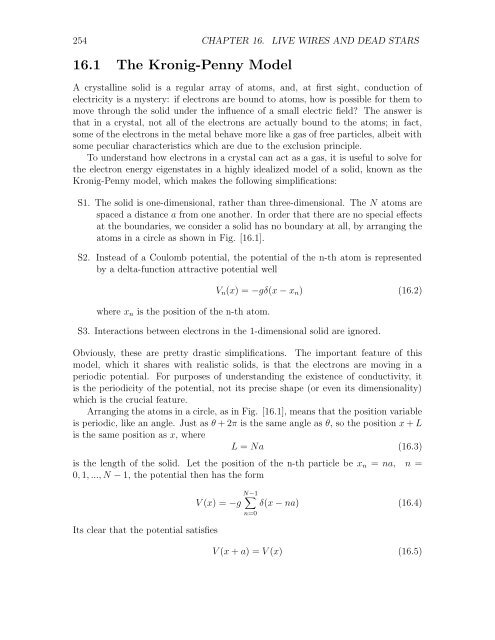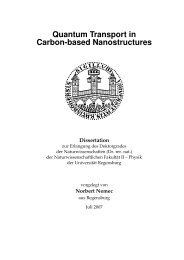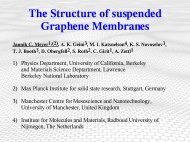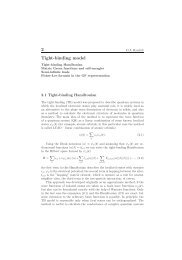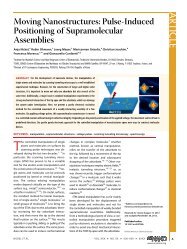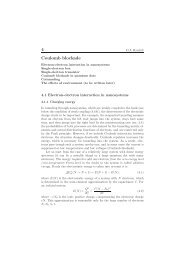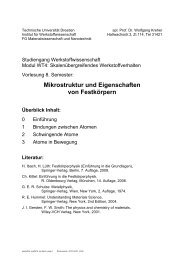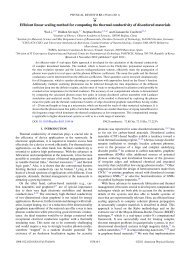16.1 The Kronig-Penny Model
16.1 The Kronig-Penny Model
16.1 The Kronig-Penny Model
You also want an ePaper? Increase the reach of your titles
YUMPU automatically turns print PDFs into web optimized ePapers that Google loves.
254 CHAPTER 16. LIVE WIRES AND DEAD STARS<br />
<strong>16.1</strong> <strong>The</strong> <strong>Kronig</strong>-<strong>Penny</strong> <strong>Model</strong><br />
A crystalline solid is a regular array of atoms, and, at first sight, conduction of<br />
electricity is a mystery: if electrons are bound to atoms, how is possible for them to<br />
move through the solid under the influence of a small electric field? <strong>The</strong> answer is<br />
that in a crystal, not all of the electrons are actually bound to the atoms; in fact,<br />
some of the electrons in the metal behave more like a gas of free particles, albeit with<br />
some peculiar characteristics which are due to the exclusion principle.<br />
To understand how electrons in a crystal can act as a gas, it is useful to solve for<br />
the electron energy eigenstates in a highly idealized model of a solid, known as the<br />
<strong>Kronig</strong>-<strong>Penny</strong> model, which makes the following simplifications:<br />
S1. <strong>The</strong> solid is one-dimensional, rather than three-dimensional. <strong>The</strong> N atoms are<br />
spaced a distance a from one another. In order that there are no special effects<br />
at the boundaries, we consider a solid has no boundary at all, by arranging the<br />
atoms in a circle as shown in Fig. [<strong>16.1</strong>].<br />
S2. Instead of a Coulomb potential, the potential of the n-th atom is represented<br />
by a delta-function attractive potential well<br />
where xn is the position of the n-th atom.<br />
Vn(x) = −gδ(x − xn) (16.2)<br />
S3. Interactions between electrons in the 1-dimensional solid are ignored.<br />
Obviously, these are pretty drastic simplifications. <strong>The</strong> important feature of this<br />
model, which it shares with realistic solids, is that the electrons are moving in a<br />
periodic potential. For purposes of understanding the existence of conductivity, it<br />
is the periodicity of the potential, not its precise shape (or even its dimensionality)<br />
which is the crucial feature.<br />
Arranging the atoms in a circle, as in Fig. [<strong>16.1</strong>], means that the position variable<br />
is periodic, like an angle. Just as θ + 2π is the same angle as θ, so the position x + L<br />
is the same position as x, where<br />
L = Na (16.3)<br />
is the length of the solid. Let the position of the n-th particle be xn = na, n =<br />
0, 1, ..., N − 1, the potential then has the form<br />
Its clear that the potential satisfies<br />
N−1 <br />
V (x) = −g δ(x − na) (16.4)<br />
n=0<br />
V (x + a) = V (x) (16.5)
<strong>16.1</strong>. THE KRONIG-PENNY MODEL 255<br />
providing that we impose the periodicity requirement that x + L denotes the same<br />
point as x. <strong>The</strong> “periodic delta-function” which incorporates this requirement is given<br />
by<br />
δ(x) = 1 <br />
exp [2πimx/L] (16.6)<br />
2π m<br />
<strong>The</strong> time-independent Schrodinger equation for the motion of any one electron in this<br />
potential has the usual form<br />
<br />
Hψk(x) = − ¯h2 ∂<br />
2m<br />
2<br />
<br />
N−1 <br />
− g δ(x − na) ψk(x) = Ekψk(x) (16.7)<br />
∂x2 n=0<br />
Because V (x) has the symmetry (16.5), it is useful to consider the translation<br />
operator first introduced in Chapter 10,<br />
Likewise,<br />
Taf(x) = exp[ia˜p/¯h]f(x)<br />
= f(x + a) (16.8)<br />
T−af(x) = exp[−ia˜p/¯h]f(x)<br />
= f(x − a) (16.9)<br />
Because ˜p is an Hermitian operator, its easy to see (just expand the exponentials in<br />
a power series) that<br />
T † a = T−a<br />
[Ta, T−a] = 0<br />
T−aTa = 1 (<strong>16.1</strong>0)<br />
Due to the periodicity of the potential V (x), the Hamiltonian commutes with the<br />
translation operators, which, as we’ve seen, also commute with each other, i.e.<br />
[Ta, H] = [T−a, H] = [Ta, T−a] = 0 (<strong>16.1</strong>1)<br />
This means (see Chapter 10) that we can choose energy eigenstates to also be eigenstates<br />
of T±a, i.e.<br />
<strong>The</strong>refore,<br />
TaψE(x) = λEψE(x)<br />
T−aψE(x) = λ ′ E ψE(x) (<strong>16.1</strong>2)<br />
λE = < ψE|Ta|ψE ><br />
= < T † a ψE|ψE ><br />
= < T−aψE|ψE ><br />
= (λ ′ E) ∗<br />
(<strong>16.1</strong>3)
256 CHAPTER 16. LIVE WIRES AND DEAD STARS<br />
But also<br />
ψE(x) = TaT−aψE<br />
= λEλ ′ EψE<br />
= ψE(x) (<strong>16.1</strong>4)<br />
This means that λ ′ E = (λE) −1 . Insert that fact into (<strong>16.1</strong>3) and we conclude that<br />
λ ∗ E = (λE) −1 , i.e.<br />
λE = exp(iKa) (<strong>16.1</strong>5)<br />
for some K. In this way we arrive at<br />
Bloch’s <strong>The</strong>orem<br />
For potentials with the periodicity property V (x + a) = V (x), each energy eigenstate<br />
of the Schrodinger equation satisfies<br />
for some value of K.<br />
ψ(x + a) = e iKa ψ(x) (<strong>16.1</strong>6)<br />
It is also easy to work out the possible values of K, from the fact that<br />
which implies<br />
ψ(x) = ψ(x + L)<br />
= (Ta) N ψ(x)<br />
= exp[iNKa]ψ(x) (<strong>16.1</strong>7)<br />
K = 2π<br />
j<br />
Na<br />
j = 0, 1, 2, ..., N − 1 (<strong>16.1</strong>8)<br />
<strong>The</strong> limiting value of j is N − 1, simply because<br />
exp[i2π<br />
j + N j<br />
] = exp[i2π ] (<strong>16.1</strong>9)<br />
N N<br />
so j ≥ N doesn’t lead to any further eigenvalues (j and N − j are equivalent).<br />
According to Bloch’s theorem, if we can solve for the energy eigenstates in the<br />
region 0 ≤ x ≤ a, then we have also solved for the wavefunction at all other values of<br />
x. Now the periodic delta function potential V (x) vanishes in the region 0 < x < a,<br />
so in this region (call it region I) the solution must have the free-particle form<br />
ψI(x) = A sin(kx) + B cos(kx) E = ¯h2 k 2<br />
2m<br />
(16.20)
<strong>16.1</strong>. THE KRONIG-PENNY MODEL 257<br />
But according to Bloch’s theorem, in the region −a < x < 0 (region II),<br />
ψII(x) = e −iKa ψI(x + a)<br />
= e −iKa [A sin k(x + a) + B cosk(x + a)] (16.21)<br />
Now we apply continuity of the wavefunction at x = 0 to get<br />
B = e −iKa [A sin(ka) + B cos(kb)] (16.22)<br />
For a delta function potential, we found last semester a discontinuity in the slope of<br />
the wavefunction at the location (x = 0) of the delta function spike, namely<br />
and this condition gives us<br />
Solving eq. (16.22) for A,<br />
<br />
dψ<br />
−<br />
dx |ǫ<br />
<br />
dψ<br />
dx |−ǫ<br />
= − 2mg<br />
2 ψ(0) (16.23)<br />
¯h<br />
kA − e −iKa k[A cos(ka) − B sin(ka)] = − 2mg<br />
2 B (16.24)<br />
¯h<br />
A = eiKa − cos(ka)<br />
B (16.25)<br />
sin(ka)<br />
inserting into eq. (16.24) and cancelling B on both sides of the equation leads finally,<br />
after a few manipulations, to<br />
cos(Ka) = cos(ka) − mg<br />
¯h 2 sin(ka) (16.26)<br />
k<br />
This equation determines the possible values of k, and thereby, via E = ¯h 2 k 2 /2m,<br />
the possible energy eigenvalues of an electron in a periodic potential.<br />
Now comes the interesting point. <strong>The</strong> parameter K can take on the values<br />
2πn/Na, and cos(Ka) varies from cos(Ka) = +1 (n = 0) down to cos(Ka) = −1<br />
(n = N/2), and back up to cos(Ka) ≈ +1 (n = N − 1). So the left hand side is<br />
always in the range [−1, 1]. On the other hand, the right hand side is not always in<br />
this range, and that means there are gaps in the allowed energies of an electron in a<br />
periodic potential. This is shown in Fig. [16.2], where the right hand side of (16.26)<br />
is plotted. Values of k for which the curve is outside the range [−1, 1] correspond<br />
to regions of forbidden energies, known as energy gaps, while the values where the<br />
curve is inside the [−1, 1] range correspond to allowed energies, known as energy<br />
bands. <strong>The</strong> structure of bands and gaps is indicated in Fig. [16.3]; each of the<br />
closely spaced horizontal lines is associated with a definite value of K.<br />
In the case that we have M > N non-interacting electrons, each of the electrons<br />
must be in an energy state corresponding to a line in one of the allowed energy bands.<br />
<strong>The</strong> lowest energy state would naively be that of all electrons in the lowest energy
258 CHAPTER 16. LIVE WIRES AND DEAD STARS<br />
level, but at this point we must invoke the Exclusion Principle: <strong>The</strong>re can be no more<br />
than one electron in any given quantum state. Thus there can a maximum of two<br />
electrons (spin up and spin down) at any allowed energy in an energy band.<br />
At the lowest possible temperature (T = 0 K), the electrons’ configuration is the<br />
lowest possible energy consistent with the Exclusion Principle. A perfect Insulator<br />
is a crystal in which the electrons completely fill one or more energy bands, and there<br />
is a gap in energy from the most energetic electron to the next unoccupied energy<br />
level. In a Conductor, the highest energy band containing electrons is only partially<br />
filled.<br />
In an applied electric field the electrons in a crystal will tend to accellerate, and<br />
increase their energy. But...they can only increase their energy if there are (nearby)<br />
higher energy states available, for electrons to occupy. If there are no nearby higher<br />
energy states, as in an insulator, no current will flow (unless the applied field is so<br />
enormous that electrons can ”jump” across the energy gap). In a conductor, there<br />
are an enormous number of nearby energy states for electrons to move into. Electrons<br />
are therefore free to accellerate, and a current flows through the material.<br />
<strong>The</strong> actual physics of conduction, in a real solid, is of course far more complex<br />
than this little calculation would indicate. Still, the <strong>Kronig</strong>-<strong>Penny</strong> model does a<br />
remarkable job of isolating the essential effect, namely, the formation of separated<br />
energy bands, which is due to the periodicity of the potential.<br />
16.2 <strong>The</strong> Free Electron Gas<br />
In the <strong>Kronig</strong>-Penney model, the electron wavefunctions have a free-particle form in<br />
the interval between the atoms; there is just a discontinuity in slope at precisely the<br />
position of the atoms. In passing to the three-dimensional case, we’ll simplify the<br />
situation just a bit more, by ignoring even the discontinuity in slope. <strong>The</strong> electron<br />
wavefunctions are then entirely of the free particle form, with only some boundary<br />
conditions that need to be imposed at the surface of the solid. Tossing away the<br />
atomic potential means losing the energy gaps; there is only one ”band,” whose<br />
energies are determined entirely by the boundary conditions. For some purposes<br />
(such as thermodynamics of solids, or computing the bulk modulus), this is not such<br />
a terrible approximation.<br />
We consider the case of N electrons in a cubical solid of length L on a side. Since<br />
the electrons are constrained to stay within the solid, but we are otherwise ignoring<br />
atomic potentials and inter-electron forces, the problem maps directly into a gas of<br />
non-interacting electrons in a cubical box. Inside the box, the Schrodinger equation<br />
for each electron has the free particle form<br />
− ¯h2<br />
2m ∇2 ψ(x, y, z) = Eψ(x, y, z) (16.27)


